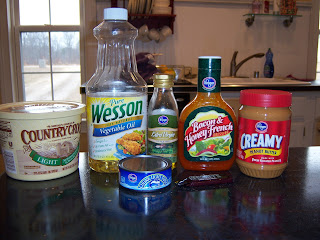In most fat-free or low-fat products, the fat is replaced with sugar, which is not any healthier than fat, and may actually be worse. What we normally think of as fat, as a broad term, is saturated fat. This is the bad fat, which along with cholesterol can lead to higher blood cholesterol levels and heart disease risk.
What we have left out, though, are the good fats, the unsaturated fats-polyunsaturated and monounsaturated. These fats are common in the Mediterranean diet, and have shown benefits to heart health and even to weight management. The foods pictured below all contain healthy, good fats. Foods like nuts, fish, vegetable oils, and even chocolate are good for your health. They have been shown to improve cholesterol levels and to reduce inflammation throughout the body. In fact, the new Dietary Guidelines for Americans encourage increased polyunsaturated fat intake.
 |
| Good fats. |
The bad fats.
If you grew up in the South like me, your mother probably had a grease cup. The drippings from bacon and sausage filled this cup, and were used to fry and prepare other foods. Unfortunately, this type of fat is mostly saturated fat-the bad fat. High fat meats also contain cholesterol, which should be limited. The rule of thumb is to limit fats that are solid at room temperature, as they are usually saturated fats. Try limiting high fat cuts of meat, and replace them with seafood or lean meats. Eggs are also fine in moderation. Also cut back on dairy fats like whole milk and soft cheeses. Try 1% milk, non-fat yogurt, and part-skim mozzarella cheese. If you eat high-fat dairy such as butter or ice cream, just have a small amount. Substitute grease drippings with vegetable oil. Olive oil has been the gold standard for a few years now, but any vegetable oil is fine, and is much less expensive than olive oil or even butter.
 | |||
| Bad fats. |
No comments:
Post a Comment